|
A cross sectional study of online
shopping behavior trends of electronics
in UAE: A case of Ajman

Sonia Singh (1)
Bhopendra Singh (2)
(1) Dr Sonia Singh
Assistant Professor,
Computer College
P.O.Box No. - 35529
Dubai, United Arab Emirates
(2) Dr. Bhopendra Singh
Assistant Professor
Amity University
P.O.Box No. - 345019
Dubai, United Arab Emirates
Correspondence:
Dr Sonia Singh
Computer College
P.O.Box No. - 35529
Dubai, United Arab Emirates
Email: sonia@computercollege.ac.ae

Abstract
Across the world e-commerce has made
life fast but simple, easy but full
of innovation for individuals and
groups. Internet buying and trade
has a global reach and a is a strategy
for many corporations for expansion
and growth. But online shopping consumer
behavior is different from the physical
market where anyone can see, touch
and feel the product. Online customers
always seek new products, new attractiveness
and importantly price compatibility
with their budget and for that they
don't have any limitations to online
shopping. UAE is one of the young
nations which has seen a lot of advancement
in less time especially in life style,
and latest technology is the indicator
of high life style. In this paper
the author has tried to know the consumer
behavior in online shopping of electronics
and provide a valuable insight to
identify some important factors which
lead to consumer buying behavior in
online shopping of electronic products
in UAE by primary data collection
in the smallest emirate of the UAE
i.e. Ajman, to show the changing trend
in the country. There is huge difference
in the consumer behavior of the two
big Emirates i.e. Abu Dhabi and Dubai,
to other emirates. In other emirates
perception, family and social network,
education, language, age, economic
factors, income distribution, facilities
available in society like technology,
are more deciding factors of consumer
behavior. This paper also provides
a solution to online stores sellers
which may help the sellers to promote
their products in light of consumer
behavior theories.
Key words: Online shopping,
electronics, consumer behavior, purchase
factors

Introduction
Consumers' behavior is different in
every consumer and is influenced by
buying habits and choices and tempered
by psychological and social drivers.
In this technical era the three W's
i.e. World Wide Web is structured
around the people where social and
professional circles are influential
and leads to online buying. This world
is a technical world and because of
the popularity of interactive media
and latest technologies, conventional
marketing has changed as companies
and customers have both changed; there
is a revolution in marketing and commerce
through providing a number of services
such as communications, information
access and transactions, entertainment,
banking, insurance, advertising, education
from pre nursery to doctorate, paying
fees and buying and selling, which
also opens up possibilities in the
areas of marketing, customer service
and feedback, lower transactions and
ordering costs, and customer retention.
The Internet has developed channels
for both business managers and consumers
to achieve their own goals as it enables
businesses to reach their customers
worldwide, and consumers of all age
groups use this channel to research,
select, and purchase products and
services from businesses around the
world. Business and consumers must
take advantage of this information.
Now almost all companies are doing
their business online by using their
websites as live showrooms of their
products and services because companies
have observed an increment in customer
segments for online shopping. Online
shopping trends among most consumers
began by sending flowers, gifts, cakes
on special occasions like birthdays,
and most importantly Valentines day,
but now it is in its advanced stage
where anyone can buy anything from
rare medicine to most advanced mobile
phones. One important point here is
that consumer behavior in buying online
electronic products is critical compared
to non electronics because not having
the advantage to physically examine
the product, to maybe judge any wear
or tear, or to understand the technicality
of the product from sales representatives
which is a very decisive purchase
factor for most buyers. Moreover ,
when consumers identify or recognize
the need for buying some product/service
online and search for information
on the internet, they look for alternatives
and finally just before making a purchase
best suited to their need they are
bombarded by several factors which
limit or influence the purchase decision
,which is quite high in the case of
electronic products.
Research Purpose
Due to tremendous growth in the UAE,
interactive media, globalization and
above all the UAE philosophy of adopting
a geocentric approach, the importance
of online shopping is increasing because
of its convenience, easiness and speed.
So the research question of this paper
is how the consumers of the UAE behave
while shopping online; to identify
and analyze consumer behavior towards
online shopping of electronics goods,
keeping in mind the UAE;, to identify
the important factors which influence
online shopping behavior; to explore
more to know why online shopping of
electronics products is less attractive
and also to relate consumer segments
with identified factors and to suggest
some of the strategies to online marketers
to make their product more saleable
online.
Research Methodology
Our research is deductive in nature
where we have collected and analyzed
the primary date to find the factors
which influence online consumer behavior
especially for electronic items, such
as low price, non-availability in
local store, time saving, to know
consumer concerns about online shopping,
like privacy, trust factor, after
sales service, delivery and return,
quality of goods and services and
consumer characteristics about these
demographics. In order to measure
underlying factors to buying of electronic
products online we have calculated
factor analysis, a fantastic data
reduction technique by combining related
variables to factors. We have also
calculated average rating to find
the main barriers in online shopping.
In the research the questionnaire
has main segments such as demographics
variables, general online purchase
behavior and specific electronics
item online purchase behavior. The
questionnaire was filled in by locals
of Ajman who know English, and have
internet access. In order to meet
time and resource constraints, specific
populations in the researcher's circle
were used. Out of 327 questionnaires
67 were discarded as they were not
completely filled in. So 250 respondents
were studied for analysis and research.
In research there are many limitation
like we had 250 respondents initially,
but most of the study was based on
only with 95 respondents which comprises
only 38% of respondents, as they have
shopped online for electronic products.
Literature Review
Different theories of consumer behavior
suggest that consumers behave differently
for online and offline shopping. There
is a difference in consumer behavior
of online and traditional shopping,
though both include factors like social,
cultural, personal and psychological
but influence of these factors is
more on traditional shopping and online
shopping is more based on consumer's
individual point of view and personal
perceptions. Online consumers are
restricted by social, cultural, environmental
and psychological factors. Online
shopping has its own character though
it is a development and supplement
of traditional shopping which had
its own characters (Na Wang 1, 2008,
P4). From this causal model of information
research (Yuan Ago, 205, P 10) defines
types of antecedents for online shoppers
including personal, product, media
and situational factors. For every
customer there are our choices to
purchase 1) Search online and buy
offline 2) Search offline and buy
online 3) Search and buy online 4)
Search and buy offline. Online shopping
consumer behavior is also called online
buying behavior and internet shopping
/ buying behavior which has a direct
relationship with five elements such
as e-stores, logistics support, product
characteristics, websites' technological
characteristics, information characteristics
and home page presentation ( J. Johnson
, 1999. P.4). In the model on consumer
behavior online (Turban , 2010, P
183) has found that the electronic
environment consists of three variables
such as independent variables (also
called personal and environment characteristics),
intervening or moderating variables
(under vendor control) and decision
making process variables (affected
by independent and intervening variables).
Online shopping is very much influenced
by experience and an experienced online
shopper has more trust and better
feeling on online services than those
who have no prior online shopping
experience (Goldsmith and Goldsmith
2002, pp. 318-28). Online purchasing
is very much dependent on all those
factors which have a strong effect
on consumer life style and also has
compatibility with it, like positive
attitude towards technology, ability
to accept multiple types of new technologies,
online skills, knowledge and online
experience becomes the main factors
for online purchasing ( Bidgoli 2004,
P 272). From research it also has
been shown that the formation of an
online consumer is strongly influenced
by their personal experience, direct
marketing, mass media, influence of
their social network and the internet
and it also has been shown that direct
experience (e.g. Product usage) is
more attractive towards shopping rather
than indirect experience (e.g. Reading
a print ad) (Schiffman, 2009, P258).
For online marketing it is very important
for companies to be knowledgeable
about factors such as consumer attitudes,
values, beliefs, opinions, buying
habits, and buying decisions in different
settings and also they should recognize
many dimensions of human behavior
and decision-making is constituted
by national culture (Soares, Farhangmehr,
& Shoham, 2007). Utilitarian shopping
behavior is known as goal oriented
consumer behavior and for decision
making purposes it is deliberately,
efficiently and pre planned (Bidgoli
2004, P 272). Goal oriented online
customers are rational and efficient
in decision making, task oriented,
specifically directed and seek to
complete their task quickly as they
are focused and determined about their
purpose of shopping. Research shows
that goal oriented online shoppers
value convenience and easiness and
are likely to buy electronics goods
over the internet (Yuan, Goa, 2005,
P.56). In the process of online purchasing
there are three main dimensions: Human
Computer interaction (HCI), behavioral
and consumerist orientation (Wan,
2009, P 19). In online shopping, communication
is very intensive as the customer
gets the product information like
price, delivery cost, time, quantity,
description by electronic communication,
(Rosen # Purinton, 2004) shopping.
Web trust can affect online purchase
decisions and increase consumers'
trust towards the online seller. It
is more important to manage the general
image of the website than emphasize
the functionality of the site. The
web trust can also be gained by positive
experience between online buyers and
sellers. There are 4 major factors
as components of web trust - transaction
security, website property, navigation
functionality and personal variables.
Discussion on results
Demographic segmentation of respondents:
The first segment of questionnaire
is a general segment about demographics
of respondents is shown in Table 1.
In the survey of 240 respondents we
had almost 72.40% males and 26.6%
female participants, so the majority
of respondents are males who are main
decision makers for buying electronics
products. Also when we analyzed the
age distribution of respondents we
find that the young generation who
have a fascination for electronics
products are mainly our respondents
as 74.8 % respondents are of age 20
to 30 years and the rest are above
31 years. The analysis of educational
background of respondents shows the
highest frequency of 46% of respondents
falls under educational category of
diploma and 22% are high school and
rest are for bachelors and masters
level. The analysis of income distribution
is very surprising as the highest
frequency, that is almost 48%, fall
under don't want to tell category,
which is surprising and it may be
happening because most of the respondents
are male and they are reluctant to
tell their income and almost 28% of
respondents come under the category
of 20000-30000 AED.
Table 1: Demographic Characteristics
of Respondents
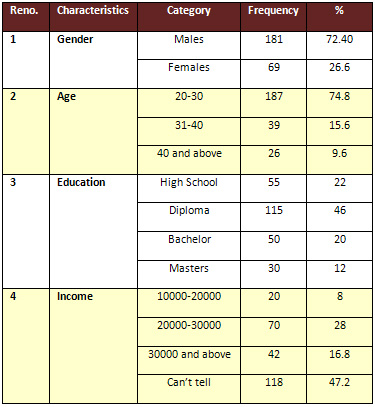
Analysis of buying online:
Frequency and duration of buying online:
The first thing we want to know is
how frequently people of Ajman buy
online products and also how long
have they been buying.
Table 2: Frequency and duration
of buy product online
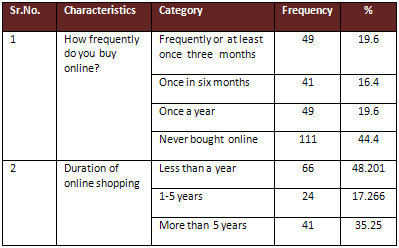
Almost 44.4% of total respondents
have never purchased anything online,
whereas 19.6% of respondents have
purchased something at least once
in the last three months and the same
once in a year. It is very much clear
from data that the majority of people
in Ajman are not buying things online
and also from the above date we came
to know that almost 55.6% people have
online shopping experience, but for
in-depth analysis it was important
to know how long they are experiencing
the online shopping experience. 48%
of respondents have been doing online
shopping for less than a year and
17% have been doing it for the last
five years and almost 35% are doing
online shopping for more than 5 years,
which shows that most people of Ajman
are not addicted to online shopping,
rather most of them are currently
involved in it which shows the sign
of youth awareness, usage and adaptibility
of latest technology and market.
Analysis of Product Segment and retail
store visit before buying :
Now our research is moving towards
being topic specific because the analysis
of this question was important for
us to see the trend of type of products
people of Ajman purchase to take our
research further.
Table 3: Buy Online Product Segmentation
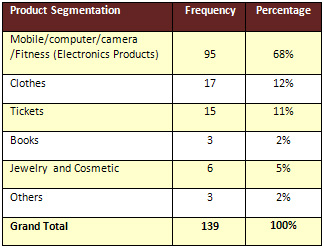
After the analysis we got many surprising
results as we found that demand of
online electronics products is on
the high side i.e. 68% of respondents
buying electronic items online. Clothes
and tickets come after that, almost
12% and 11% whereas the products like
Jewellery, books and others have very
less online demand. Buying behavior
of every customer is different especially
when buying online which depends on
many factors like type of products,
cost and time effectiveness. When
we asked before buying how many people
visit the retail store to our surprise
again almost 75% respondents visit
the retail store and all who buy online
electronics products definitely go
to retail store.
Analysis of buying online electronics
product:
Now from here our research was confined
to 95 respondents whoare almost 40%
of our total respondents initially.
Now they form the main focus of our
research which is on buying of online
electronics products. Almost 60% of
95 respondents have purchased online
electronics products once in a year
, 1-3 times year by 26% and only 14%
bought more than 3 times. From the
sample it can be easily analyzed that
the people of Ajman are not addicted
to online buying of electronics products
but also when we analyise how many
online stores they visit before actual
buying then to our surprise a good
number, almost 80% of 95 respondents,
visit more than 3 online stores before
actually buying. Therefore it is recommended
to the online electronics product
companies to do marketing research
before launching the products online
to gain trust and to deliver the right
product at the right price with after
sales service to increase the sales
of online products in Ajman.
Analysis of motivation and factors
behind purchase:
Firstly in order to find the motivation
behind purchase that urges consumers
to buy certain electronic products
online, we asked how they got an idea
of buying specific electronics products
through an online store and we found
that 76 % of 95 respondents are influenced
by family and friends and a few see
an online or offline advertisement.
So there is a huge scope to increase
the sales of electronics products
by online and offline marketing as
the majority of the people buy electronics
goods on recommendation of family
members and social cycles.
Consumer buying behavior for online
shopping is different from traditional
shopping especially for electronics
products. So to analyze the critical
factors affecting the consumer's mind
for purchase of electronics products
we have used factor analysis. In order
to improve the reliability of data
and to reduce potential multicolinearity
among the items, the respondents'
ratings are subject to principal axis
factoring with varimax rotation.
Table 4 : KMO and Bartlett's Test

From Table 4, the KMO value is 0.747
that is more than the required value
of 0.60 for the appropriateness of
factor analysis, which indicates that
74.7% of the sample is error free
and in the remaining 25.3%, there
can be a chance of error. Bartlett's
test of sphericity was done to examine
the hypothesis that variables are
uncorrelated in population. So here
our hypothesis can be
Ho: In online purchase of electronics
goods, there is a significant indifference
of all the factors affecting.
H1: In online purchase of electronics
goods, there is significant difference
of all the affecting factors. The
value of Chi-square test (259.569
with significance level 0.000) signifies
the rejection of null hypothesis,
which indicates that there is a significant
difference between the factors affecting
online purchase of electronics goods.
Table 5 shows the table of communalities
before and after. The communalities
reflect the amount of variance of
variable shares with all other variables
to the proportion of variance explained
by the common factor; here 81.4% of
the variance associated with question
1 is common, or shared, variance.
Table 5: Communalities
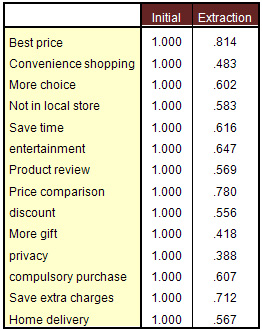
Extraction Method: Principal Component
Analysis.
Table 6, labeled Total Variance Explained
lists the Eigenvalues associated with
each factor before extraction, after
extraction and after rotation. Eigen
value indicates the total variance
attributed to the factor; higher the
Eigen value the higher will be variance
explained by the factor. As here Eigenvalue
for factor1 is 3.690 and accounts
for 26.354% of variance. From the
Table we can observe that the first
few factors explain relatively large
amounts of variance (especially factor
1) whereas subsequent factors explain
only a small amount of variance. After
extraction of Eigenvalues greater
than 1, we left with five factors,
with 59.590 % of cumulative variance.
In the last part, the eigenvalues
of the factors after rotation are
displayed to have an effect on optimizing
the factor structure and to equalize
the relative importance of five factors.
Rotation, factor 1 accounted for considerably
more variance than the remaining four
(26.354% compared to 9.18, 8.38, 8.094
and 7,573%), however after extraction
it accounts for only 19.36% of variance
(compared to 12.64, 10.05.9.03 and
8.49% respectively).
Table 6: Total variance explained
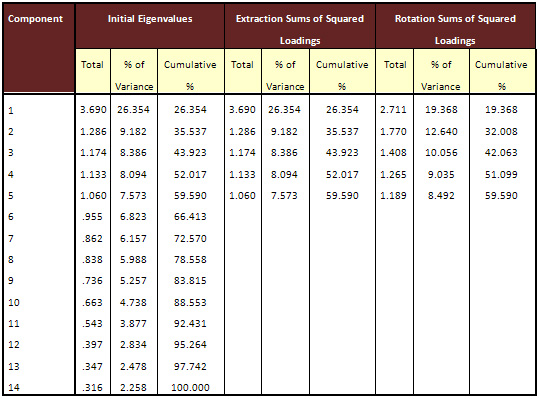
Extraction Method: Principal Component
Analysis.
Table 7 contains component loading
which is nothing else but the correlation
between variables and factors in order
to formulate an interpretation of
the factors or components by looking
for a common thread among the variables
with large loadings. All loadings
less than 0.4 are suppressed in output
as low correlations are not meaningful
now.
Table 7: Component Matrixa
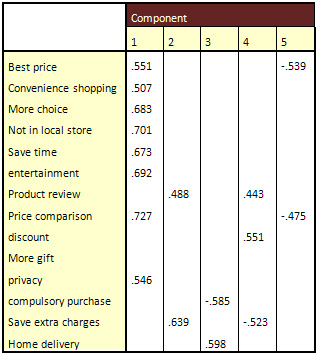
Extraction
Method: Principal Component Analysis.
a. 5 components extracted.
Table 8 is nothing else but the alternative
representation of loading after rotation.
Here though the total variance is
explained it remains the same but
the amount of variance explained by
each variable changes to show the
relationship of different factors
with other variables.
Table 8: Rotated Component Matrixa
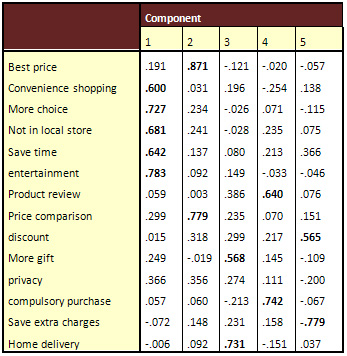
Extraction Method: Principal Component
Analysis.
Rotation Method: Varimax with Kaiser
Normalization.a
a. Rotation converged in 6 iterations.
With the help of Table 8, we will
identify the variables with high loading
and try to give a phase which is a
name given to a factor by combining
meaning of factors. Factor 1 includes
convenience shopping, more choice,
not in local store, saves time and
entertainment which are the factors
for online purchase of electronics
goods which can be broadly defined
as the easiness and fun factors for
online purchase of electronic products.
Factor 2 includes best price and price
comparison which broadly represents
price analysis. Factor 3 includes
more gifts and home delivery which
together can be named as happy shopping
from home as you are getting products
with more gifts at home only. Factor
4 can be named as product trust as
it includes product analysis and compulsory
purchase. As factor 5 has discount
and saves on extra charges it can
be named as value for money.
Main barriers in online shopping:
At the the end of the questionnaire
we asked all our respondents to rate
the main barriers to online shopping.
It was asked of all respondents who
have been doing online shopping and
also from those respondents who never
shopped online, to judge their concern
or to gain an experience of online
shopping. This analysis is very important
for sellers as after knowing the barriers
for buying online they can work to
change the mindset of consumers for
online purchasing of electronic goods.
Table 9: Main barriers in online
shopping
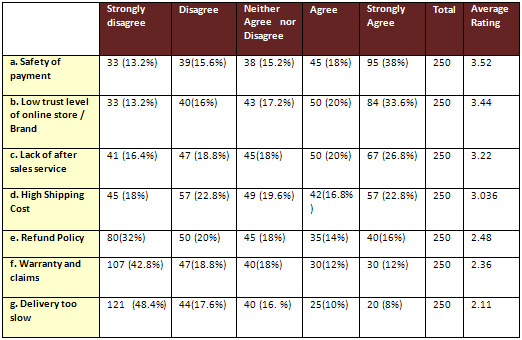
From the calculation of average rating
of all respondents, which is an indicator
of average sentiments of all respondents,
we analyze that sellers of online
electronic goods must provide secure
and safe payment solutions to their
customers also to try to create more
trust among customers for their online
stores and also should work to provide
more after sales service as the average
rating of these three parameters is
3.52, 3.44 and 3.22.
Conclusion
From the research we conclude that
the people of the Emirate of Ajman
are buying online but not as rapidly
as other emirates especially Abu Dhabi
and Dubai. Study reveals that online
shopping is mostly influenced by family
networks or social circles and also
people do online shopping because
of convenience and time saving. Online
shopping is becoming popular among
the young generation and also over
the past year more people have shown
more inclination towards online buying.
Before buying they check both offline
stores and online stores to compare
price, quality or offers. The potential
of online shopping is large, but still
there is a safety issue which is a
barrier to online shopping due to
high internet hacking people are afraid
to share their personal and financial
information on the internet. Companies
must emphasise on the safety of credit
card and customer personal information
data. After sales service and attitude
of sellers by maintaining good communication
with consumers can increase consumer
purchase intention and by increasing
trust the possibility to repeat purchase.
So it is necessary for the online
shopping industry to have continuous
improvement in terms of the product
variety, services, efficiency, security
and popularity of brand to meet consumer
changing needs and expectations.
Bibliography
Ayass, T. (2009). Investigation of
the antecedents of an e-commerce trust
model. USA: ProQuest.
Barry Silverstein. (2002). Business
to Business internet marketing. Canada:
Jim Hoskins.
Bashir Adil ,(2013) Consumer Behavior
towards online shopping of electronics
in Pakistan ,Thesis
Bidgoli, H. (2004). The Internet encyclopedia.
Canada: John Wiley and Sons.
Brown, D. B. (2004). Consumers Getting
Savvy About Online Shopping. (Keynote,
Interviewer)
Goldsmith, R.E. and Goldsmith, E.B.
(2002), "Buying apparel over
the internet", Journal of
Product & Brand Management, Vol.
11 No. 2, pp. 318-28. J.Johnson, S.
B. (1999).Predictors of online buying
behavior. Jansson-Boyd, C. V. (2009).
Consumer Psychology. England: McGraw-Hill
International.
Na Wang 1, 2.D. (2008).Study on the
Influencing Factors of Online Shopping.
Changchun: Atlantis Press.
Nielson.(2010). Global Trends in Online
Shopping.USA: Nielson.
Paim, N. D. (2011). Students' Online
Shopping Behavior: An Empirical Study.
Singapore: IPEDR.
Pedersen, P. E. (2002, 2 22). Search
mode and purchase intention in online
shopping behavior. 1-35.
Rosen, E. E., & Purinton, E. (2004).
Website design: Viewing the web as
a cognitive landscape. Journal of
Business Research , 57, 787-94
Saaksjarvi, M. (2007). Consumer mind
set and attitude toward online marketing
messages. In Int J. Internet Marketing
and Advertising (pp. 26-30). Finland:
Inderscinece Enterprises Ltd.
Schiffman.(2009). Consumer Behavior.
India: Person.
Soares, M., Farhangmehr, M., &
Shoham, A. (2007). Hofstede's dimensions
of culture in international marketing
studies. Journal of business research,
60, 3, 277-284.
Turban. (2010). Electronic Commerce:
A Managerial Perspective 2006, 4/E.
New Delhi: Surabh Printers Pvt Ltd.
Wan, Y. (2009). Comparison-Shopping
Services and Agent Designs.USA:Idea
Group Inc (IGI).
Yoon, Sung-Joon (2002), "The
antecedents and consequences of trust
in online-purchase
decisions". Journal of Interactive
Marketing, Vol.16 No.2, pp.47-63.
Yuan Gao. (2005). Web systems design
and online consumer behavior. London:
Idea Group Inc (IGI).
|